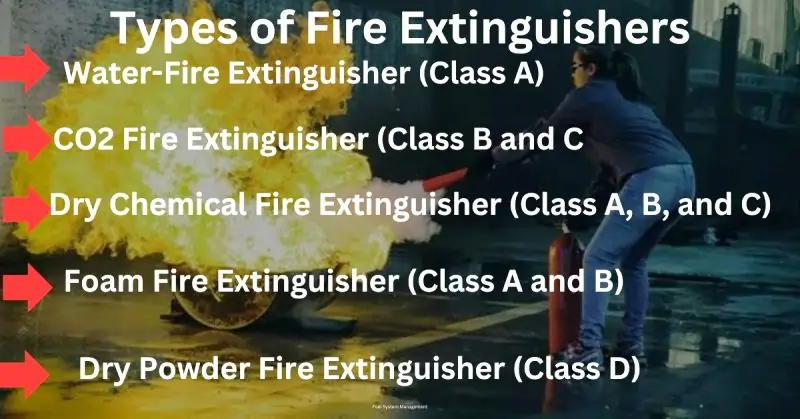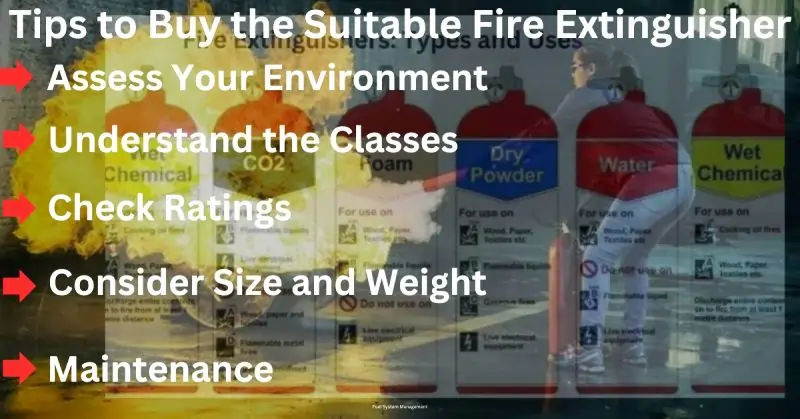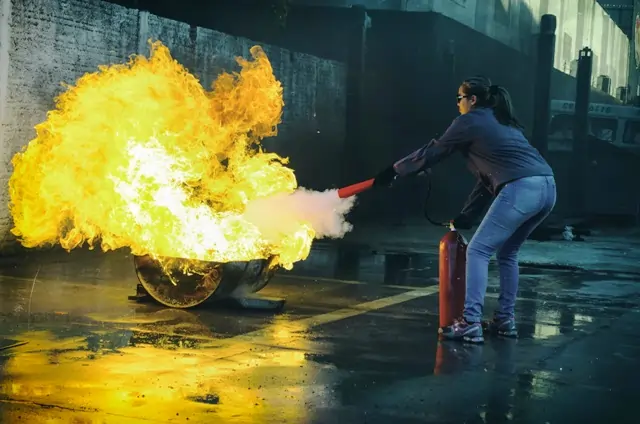Types of Extinguishers
Fire safety is a critical aspect of protecting lives and property. Knowing how to respond in the event of a fire can mean the difference between a minor incident and a major disaster. One essential component of fire preparedness is understanding the different types of fire extinguishers and their specific uses. Each type of extinguisher is designed to combat particular classes of fires, making it crucial to choose the right one for the situation.
In this blog post, we will delve into the importance of fire safety and explore the 7 vital fire extinguisher types you need to be aware of for ultimate safety. We will cover water, foam, dry powder, CO2, wet chemical, and Class D fire extinguishers, discussing their uses, suitable environments, and pros and cons. By the end of this guide, you’ll be equipped with the knowledge to make informed decisions about fire extinguishers and enhance your fire safety preparedness.
Types Of Fire Extinguishers And Their Uses

Fire extinguishers come in various types, each designed to combat specific classes of fire. Understanding these types is crucial for effective fire prevention and control. Here are the five vital options:
Water-Fire Extinguisher (Class A):
These extinguishers mostly contain water, though occasionally other additives are also utilized. Pure water fire extinguishers have the disadvantage that they should not be used in cold temperatures since the water within will freeze and leave the extinguisher useless. Antifreeze is a substance that some water fire extinguishers include, making it possible to use the extinguisher in freezing temperatures.
Wetting agents, which are intended to help boost the effectiveness of water-type fire extinguishers against fire, may occasionally be included in these devices as well. These extinguishers are primarily designed to put out Class A fires.
Extinguishers that use distilled water and release it as a thin mist rather than a solid stream are known as water mist extinguishers. Extinguishers with water mist are utilized.
CO2 Fire Extinguisher (Class B and C
The fact that carbon dioxide (CO2) leaves no residue behind after usage is the main benefit of CO2 fire extinguishers. This can play a big role in situations when expensive and delicate electrical equipment needs to be protected. Labs, printing or duplicating rooms, and food preparation spaces are some other typical applications. Extinguishers that release carbon dioxide are approved for use on Class B and Class C fires.
The agent has a relatively small range of 3 ft to 8 ft (1 m to 2.4 m), as it is released as a gas/snow cloud. Because the agent can rapidly spread, it is not advised to use this kind of fire extinguisher outdoors in windy weather or indoors in places with strong air currents.
Dry Chemical Fire Extinguisher (Class A, B, and C):
There are various types of dry chemical fire extinguishers that can be used to put out fires. One kind is referred to as “Ordinary Dry Chemical.” This makes use of a finely ground powdered material. It can either be based on potassium or sodium bicarbonate. The powder in these extinguishers has been prepared to ensure that it flows well and doesn’t clump up while being stored.
A different kind is referred to as “Multipurpose Dry Chemical.” These fire extinguishers make use of powdered ammonium phosphate. They put out fires involving flammable liquids (Class B fires) in the same way as standard dry chemical extinguishers. They do, however, have an added feature. They become sticky and form a coating when they come into contact with hot surfaces in a Class A fire (such as wood or paper). This covering puts out the flames.
Foam Fire Extinguisher (Class A and B)
Foam extinguishers are important tools to keep us safe from fires. They come in different types, but the most common one is called Aqueous Film Forming Foam (AFFF). These extinguishers are good at cooling down fires and covering them with foam to stop them.
What’s cool about AFFF extinguishers is that they can work on two kinds of fires. First, there are Class A fires, which happen with normal things like wood, paper, or cloth. Second, there are Class B fires, which involve liquids that can catch fire, like gasoline and oil. So, you can use these foam extinguishers in lots of places like warehouses, storage areas (without machines or electrical stuff), paper factories, textile factories, and even in your living room at home.
When you use the foam extinguisher, the foam it sprays on the fire blocks the fire from getting air and fuel. This helps put out the flames. But here’s a tip: don’t use these extinguishers on grease fires caused by fats and oils because they might not work well, and the fire could get worse.
To make sure your foam extinguisher is always ready to help in case of a fire, you need to take care of it. Regular maintenance is important. In this article, we’ll talk about how to use foam extinguishers, what’s good about them, what’s not so good, and how to keep them in good shape. This way, you can keep your place safe from fires.
Dry Powder Fire Extinguisher (Class D)
Dry Powder Fire Extinguishers, also called ABE Fire Extinguishers, are like really helpful tools for stopping different kinds of fires. They are highly-liked because they function efficiently in a variety of crises, even when electricity is involved.
Here’s how they work: Fire extinguishers, in general, work by taking away something a fire needs to keep burning. A fire requires fuel, heat, and oxygen to survive.
Dry Powder extinguishers are filled with a special stuff called monoammonium phosphate. This stuff is like magic dust that spreads easily and covers the flames. When it covers a fire, it takes away the heat and oxygen, which makes the fire stop.
Additionally effective in keeping items from getting too hot, these extinguishers.
The dry powder can act as a shield against the heat coming from the fire. If you use a lot of this powder, it can even protect things around the fire from getting damaged.
So, in simple terms, Dry Powder Fire Extinguishers are really useful because they can put out different types of fires and keep things safe from getting too hot.
Classes of Fire

Understanding the classes of fire is crucial when choosing the right fire extinguisher:
- Class A: Class A fires are the kind where things like wood, paper, and cloth catch fire. These are everyday materials we find in our homes, offices, and outside. Think of a campfire or a pile of wood burning – those are Class A fires. When you have a Class A fire, you need to use the right fire extinguisher. Water and some dry chemical extinguishers are good for these fires because they cool down the flames and take away the heat. Heat is one of the things that fires need to keep burning. So, these extinguishers stop the fire from spreading and causing more damage.
- Class B: Class B fires are all about things that can easily catch fire, like gasoline, oil, and solvents (liquids used for cleaning or other purposes). These fires can spread really fast if they start.To put out a Class B fire, you need the right kind of fire extinguisher because water can make it worse. Special extinguishers are made to stop these fires by either taking away the oxygen they need or stopping the chemicals that make them burn. Some common types of extinguishers for Class B fires are foam, carbon dioxide (CO2), and dry chemicals. Knowing which type of fire you’re dealing with and using the right fire extinguisher is super important to stop Class B fires and keep them from spreading and causing harm.
- Class C: Class C fires are all about electricity. They happen when there’s something wrong with electrical stuff, like wires or machines. Picture overloaded plugs, broken wires, or gadgets that go haywire. Now, dealing with these fires is tricky. You can’t use water because water and electricity don’t get along, and it can make things worse. Instead, you need special fire extinguishers designed for electrical fires. These extinguishers use stuff that doesn’t conduct electricity, like dry chemicals or carbon dioxide (CO2). They work by cooling down the fire and stopping it from getting oxygen. Knowing how to handle Class C fires and using the right fire extinguisher is really important to stay safe when there’s an electrical fire happening.
- Class D: Class D fires are a bit unusual because they happen with special metals like magnesium, titanium, and sodium. These metals can catch fire more easily than the ones we commonly use, like iron or aluminum. Now, here’s the tricky part: regular water or most fire extinguishers won’t work on Class D fires. In fact, water can make them worse! To deal with Class D fires, you need special fire extinguishers. These extinguishers use things like powders or sand to smother the fire and cool it down. They basically take away the fire’s oxygen and heat. You don’t see Class D fires often in everyday life because these special metals are not very common. But if you work with these metals in places like factories, it’s super important to know how to handle them safely and use the right kind of fire extinguisher to stop these fires.
- Class K: Class K fires mostly happen in commercial kitchens, especially those where they cook with lots of oil and grease. These fires are special because they start when the hot oil or grease catches fire. Regular fire extinguishers, like the ones for normal fires, don’t work on Class K fires. Actually, using the wrong kind of extinguisher can make it worse. So, you need special fire extinguishers for Class K fires. These special extinguishers have stuff inside that’s made to fight hot oil and grease fires. It works by cooling down the oil or grease and stopping it from catching fire again. Because Class K fires are a big risk in commercial kitchens, it’s super important to have the right fire safety tools and know how to use them to keep the kitchen and the people working there safe.
Tips to Buy the Suitable Fire Extinguisher

Assess Your Environment
Assessing your environment is like taking a good look around to see if there’s anything that might cause a fire. You need to pay attention to what’s around you and what you’re up to. Here are some tips to help you out:
Check for Fire Dangers: Look for things that can easily catch fire, like paper, wood, or chemicals.
Think About Your Activities: Consider what you’re doing. Are you cooking, using tools, or dealing with electrical stuff? These things can make fires more likely.
Be Ready: Once you know what could be a problem, you can get ready. This might mean having a fire extinguisher nearby or knowing how to call for help if needed.
By checking your surroundings and being aware of things that could start a fire, you can take steps to keep yourself and others safe from harm.
Understand the Classes
Understanding fire classes is important when choosing the right fire extinguisher. Each fire class represents a different type of fire based on the materials involved. Here are some buying tips to help you match potential fire hazards with the appropriate fire extinguisher class:
- Know the Fire Classes: Familiarize yourself with the different fire classes: A, B, C, D, and K. Each class is suited for specific types of fires.
- Assess Your Environment: Consider the materials and activities in your surroundings. For example, if you’re in a kitchen where cooking oils and grease are used, a Class K extinguisher is necessary.
- Choose the Right Extinguisher: Match the potential fire hazards with the corresponding fire extinguisher class. For Class A fires (involving common materials like wood and paper), use Class A extinguishers, and so on.
- Follow Safety Guidelines: Always follow safety guidelines and ensure that your chosen fire extinguisher is up-to-date and properly maintained.
By understanding fire classes and selecting the appropriate extinguisher, you can enhance fire safety and be better prepared to tackle potential fires in your environment.
Check Ratings
- Check Ratings: Examine the UL (Underwriters Laboratories) rating on the fire extinguisher.
- Higher Numbers Mean Better: Remember, higher UL ratings indicate better effectiveness in fighting fires.
- Consider Fire Types: Match the extinguisher’s rating to the types of fires you might encounter in your environment.
- Class A, B, C, D, or K: Different classes represent various fire types, so choose an extinguisher with the appropriate UL rating for your needs.
- Prioritize Safety: Ensure the fire extinguisher you select has a high enough UL rating to handle potential fire hazards effectively.
- Regular Maintenance: After purchasing, maintain the extinguisher according to the manufacturer’s recommendations to keep it in good working condition.
By following these buying tips and checking the UL rating, you can make a wise choice and have a more effective fire extinguisher on hand for emergencies
Consider Size and Weight
- Size Matters: Think about the physical size of the fire extinguisher. It should be manageable and not too heavy for the people who might need to use it, like family members or employees.
- Accessibility: Ensure the extinguisher is easy to reach and grab in case of an emergency. It should be placed in a location where it can be quickly accessed.
- Training: If it’s for a workplace or shared space, consider the training level of potential users. Choose a size that people can handle comfortably and safely.
- Consider Mobility: If you need a fire extinguisher for a vehicle or on-the-go use, opt for a compact and lightweight model that fits in the available space.
- Check Installation Requirements: Some fire extinguishers may have specific installation requirements, like mounting brackets. Make sure you can accommodate these requirements.
- Balance Size and Effectiveness: While you want a manageable size, ensure it still has an adequate UL rating for the types of fires you may encounter.
By considering the size and weight of the fire extinguisher in relation to the people using it and the environment it’s placed in, you can make a practical choice that promotes safety.
Maintenance
- Regular Inspection: Make it a habit to visually inspect your fire extinguishers. Check for any visible damage, corrosion, or signs of tampering.
- Pressure Gauge Check: For extinguishers with pressure gauges, regularly monitor the gauge to ensure it’s in the green or proper operating range.
- Check the Seals: Inspect the safety seals or tamper indicators. If broken or missing, it could indicate the extinguisher has been used or compromised.
- Schedule Professional Maintenance: Arrange for professional servicing according to the manufacturer’s recommendations or local regulations. This may involve annual inspections and refills.
- Employee Training: Ensure that those who may use the extinguishers are trained in their proper use and maintenance.
- Replace When Necessary: If an extinguisher has been used, even partially, replace it or have it professionally serviced promptly.
- Keep Records: Maintain records of inspections and servicing for compliance and safety tracking.
Proper maintenance ensures your fire extinguishers are ready when needed and can effectively combat fires. It’s a crucial aspect of fire safety that should not be overlooked.
Conclusion:
Choosing a proper fire extinguisher is very critical for fire safety. One should have complete knowledge of the type of extinguishers and their use in the event of a fire. Your home or place of business can remain safe if you follow basic advice for making the appropriate purchase.
It can be beneficial to have a plan in place and understand the proper action to be taken with the proper extinguisher for the particular type of fire.
FAQ on ” Types Of Fire Extinguishers And Their Uses “
Q: What are the different fire extinguisher types?
A: Types include A, B, C, D, and K for specific fires.
Q: How do I choose the right one?
A: Match it to the type of fire you might have.
Q: Where to place a fire extinguisher?
A: Keep it visible and accessible where fires might happen.
Q: How to maintain it?
A4: Regularly inspect and service as per instructions.
